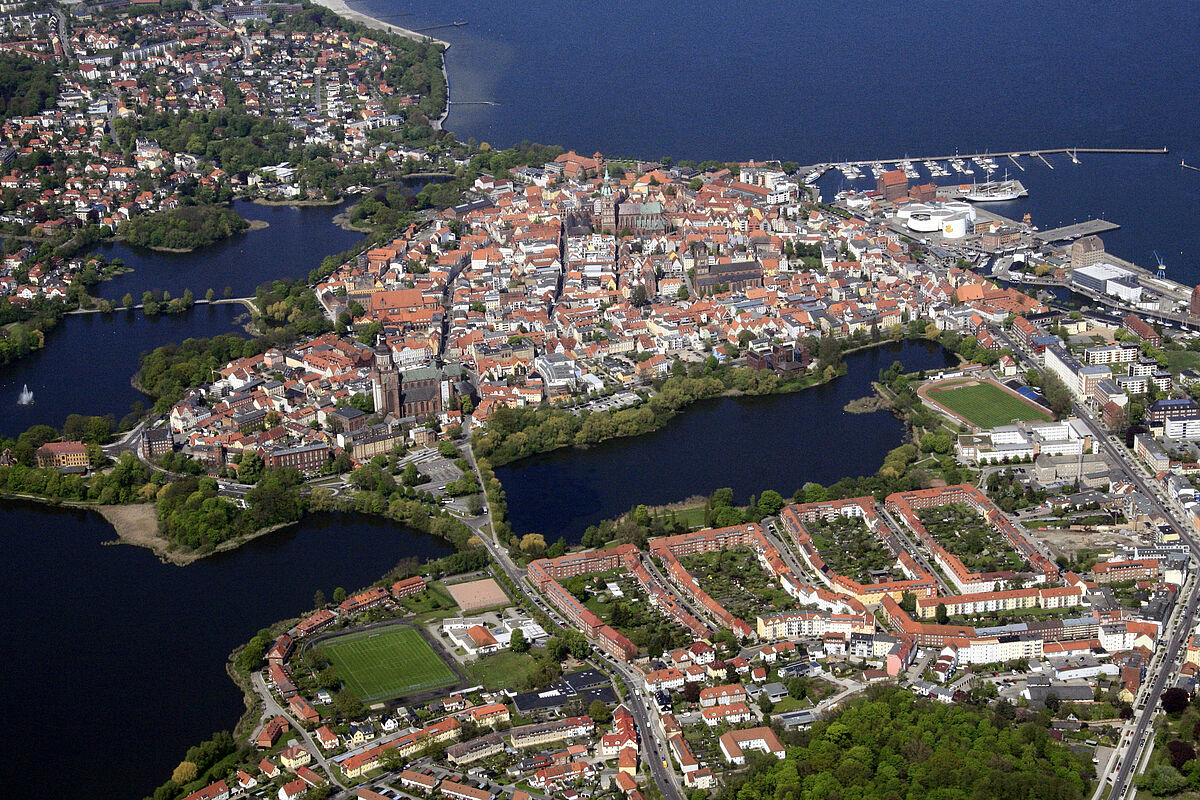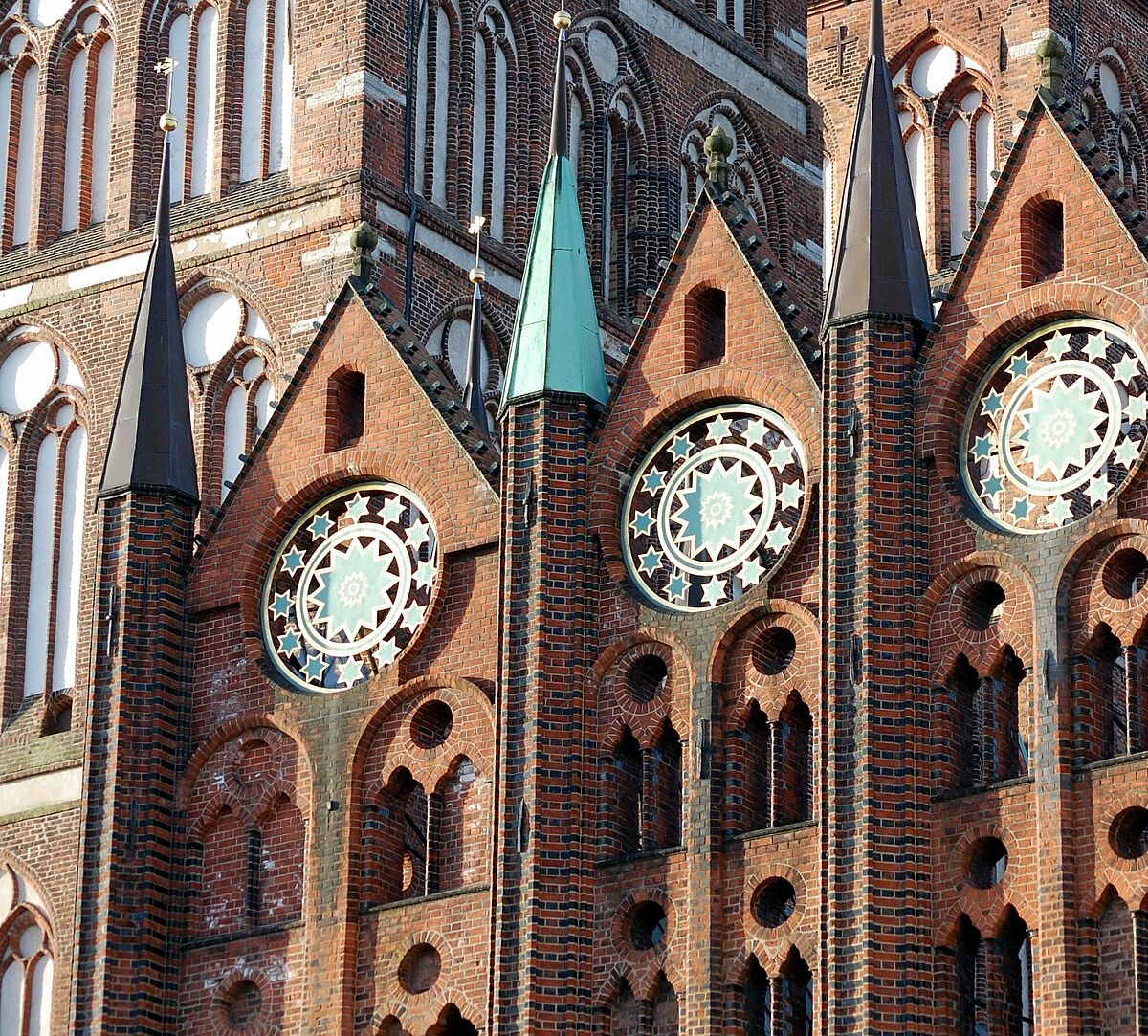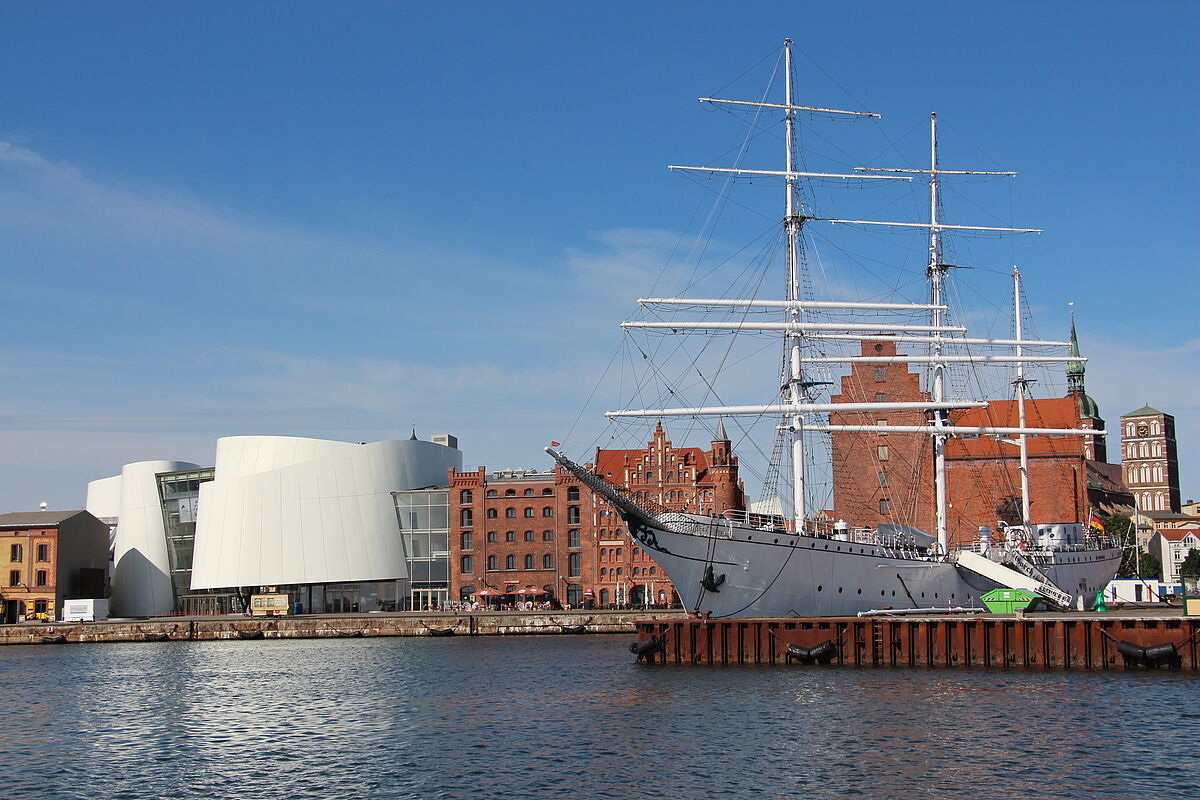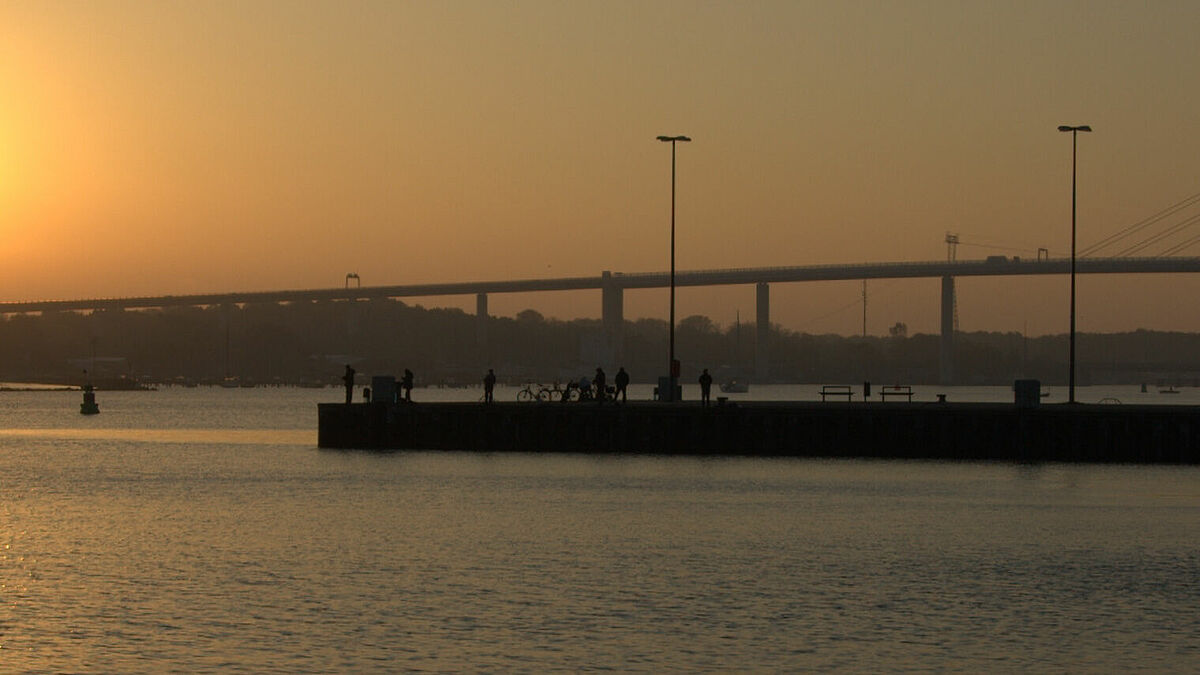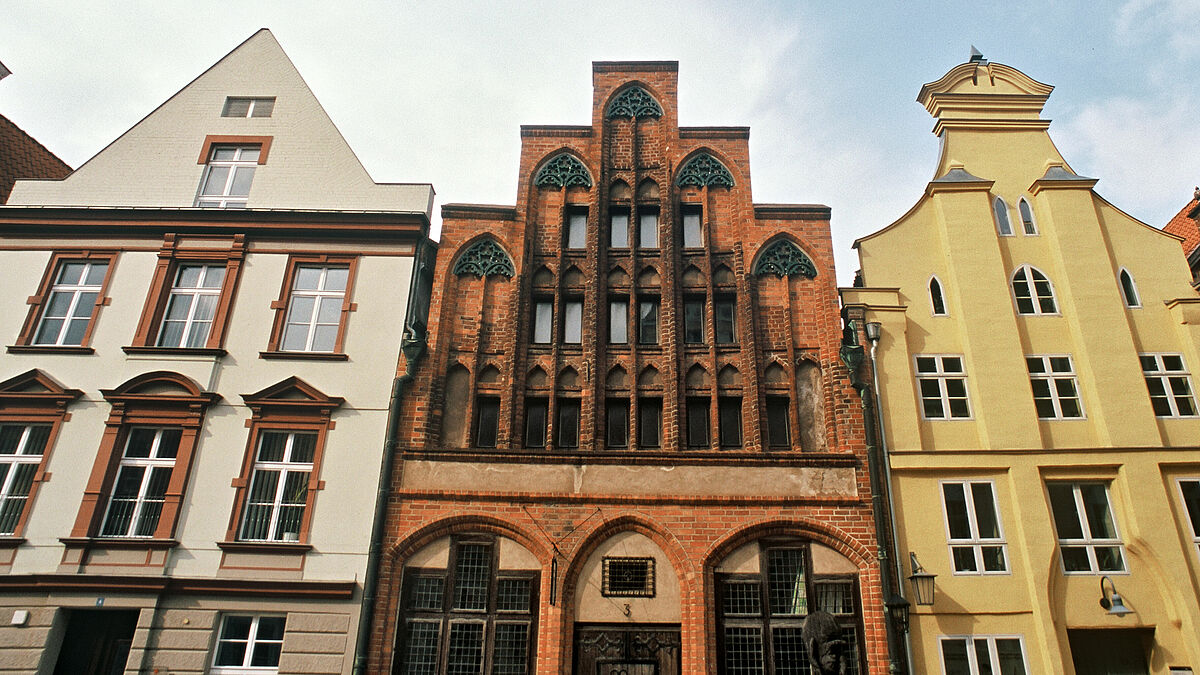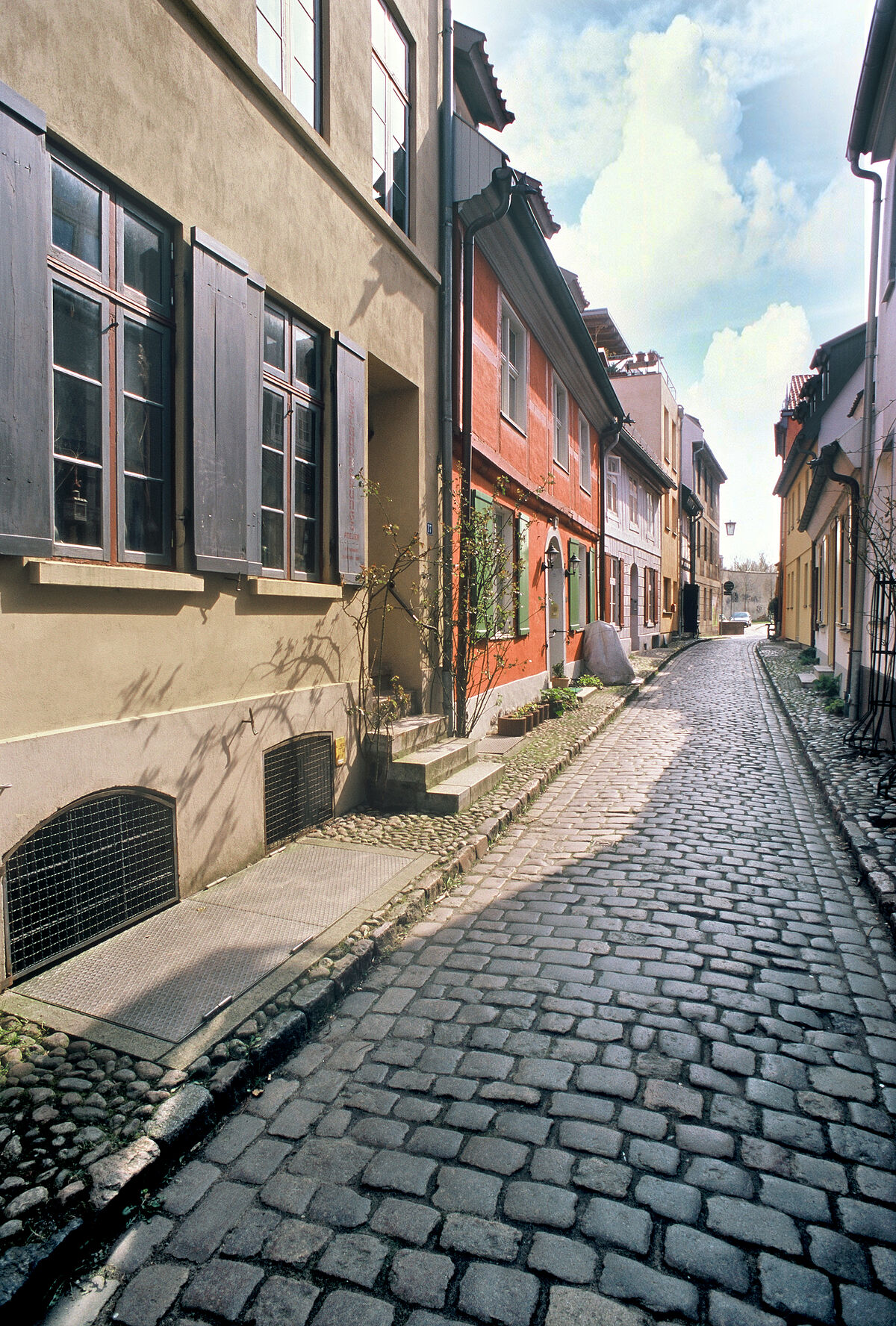With an area of 39 km² and 59,000 inhabitants, Stralsund is the largest town in Vorpommern. The year in which the venerable Hanseatic town was founded - 1 2 3 4 - marks the start of nearly 800 years of fluctuating history. Primarily due to the witnesses of the north German Brick Gothic architecture, but also those from the almost 200 years of Swedish rule, Stralsund has been mentioned together with the Grand Canyon or the pyramids of Giza since 2002 - because Stralsund's historic Old Town is a World Heritage Site - in conjunction with the old town of Wismar.
Apart from its prestigious Town Hall - the town's trademark -, the Brick Gothic churches and the very well-maintained monasteries, Stralsund proudly boasts more than 600 monuments. Several of them adorn the roads that lead from the Old Town down to the harbour, having been recently restored and given a fresh lick of paint. Their size bear witness to the former wealth of Stralsund and its importance as an intermediary trade town during the Hanseatic era.
Already back in the Middle Ages, the direct vicinity to the water shaped the unmistakable atmosphere of the town. Back then, the broad-hulled cogs belonging to the merchants and tradesmen moored in the harbour. Nowadays, sailboats, yachts and fishing boats dominate the maritime backdrop and passenger boats invite guests for outings to the nearby islands of Rügen or Hiddensee. And even if you'd prefer to stay on dry land: the smell of the sea that wafts through the town centre is guaranteed to inspire you!
Discover Stralsund's cultural treasure in the Hanseatic town's churches and museums. The art inventory of the immense Brick Gothic churches will impress you just as much as the mighty organs. In the cultural history museum you will find precious objects from the past, such as gold viking treasure from the 10th Century. Here you will find history you can get your hands on! The German Oceanographic Museum with its sites OZEANEUM and MEERESMUSEUM will take you on a breathtaking trip through the seas of the northern and southern hemispheres.
And then there's the multi-facetted shopping opportunities - from the shopping mall to the privately-owned boutiques, culinary offers to meet anybody's taste and not to forget a well-connected infrastructure with short distances, fast four-lane connection to the motorway, the bridge to Rügen and cycle paths, all making Stralsund the perfect location for your studies.
And there's more: historic town festivals such as the Wallenstein Days in July or the unequalled Long Night of Open Monuments on the first Saturday in September are among the highlights of the event calendar, just like the Sund Swim on the first Saturday in July or the Rügen Bridge Marathon on the third weekend of October.
The Hanseatic town of Stralsund is situated as if it were a pearl cushioned on the edge of the picturesque countryside of Vorpommern's Baltic Sea coast. Enjoy the nature experience at first hand: whether it's on the endless sandy beaches on the islands of Rügen and Hiddensee or the Fischland-Darß-Zingst peninsula, or whilst watching the cranes that have their resting places here for their journeys to their summer and winter quarters.
However, Stralsund is not just a town that is nice to live in, but also a location for industry, where more and more innovative service and high-tech businesses have set anchor in the wake of established companies. The maritime industry, construction, metal and wood processing and the port are all important branches of industry for Stralsund. The industrial and business estates offer good starting conditions to attract companies. The ideal position next to the sea also makes Stralsund into an important hub with its function as a portal to Scandinavia and the Baltic region...
...that completes our portrayal of a vibrant town, where tradition is joined with modern day in an appealing manner.
Have we caught your eye? Then feel free to find out more here:
Vorpommern Region
The island of Rügen, Germany's largest island, is located just the other side of the Hanseatic town of Stralsund's gates. Its beautiful landscape and fantastic Baltic Sea beaches make it a popular tourism location. The Jasmund National Park with the famous chalk cliffs, the hunting lodge Granitz, the town of Putbus, the seaside resorts of Binz, Sellin and Göhren are just some of the popular places to visit.
HOST is also directly adjoined by the 'Vorpommersche Boddenlandschaft' National Park. In autumn, it is the resting place for thousands of cranes on their way south. The charming island of Hiddensee and the Fischland-Darß-Zingst peninsula are also popular places in the surrounding area for students and guests at Hochschule Stralsund.
But also the island of Usedom, which is situated approximately 60 km from Stralsund can also be seen as a paradise for students in their spare time; and also belongs to the Vorpommern region.
If this has whet your appetite, you can find out more on the regional websites or here.
Island of Rügen - A Treasure Trove Full of Discoveries
Apart from the 60 km of fine sandy beaches, Germany's largest island, which is located right next to HOST, provides a diverse landscape and structure: you can visit the vibrant Baltic seaside resorts or the island's immense national parks, world-famous views from the cliffs, tree-lined avenues, idyllic fishing villages, or the numerous burial mounds and sacrificial stones, parks and gardens, as well as castles and mansions.
A lot of people know that Rügen is Germany's largest island. But would you have known that Rügen has 140 kilometres more coastline than the entire length of Schleswig Holstein's Baltic Sea coast? Or that Rügen is ten times bigger than Sylt, but only has a population that is three times the size? Or that it has 100 hours more sunshine per year than Munich?
Fine sandy beaches that stretch for several kilometres invite guests to take a splash or go on a recuperating walk along the beach. Whether it's a nudist, dog-friendly or sports beach or a wicker beach chair you are looking for - everyone can find just what they're looking for on Rügen. You'll love spending your holiday here in the sand.
The island of Hiddensee, a small island located beside the island of Rügen boasts three beaches that join together seamlessly. Here, you can find spots to enjoy the nature and peace and quiet all by yourself. As there are no cars on Hiddensee, bikes and horse-drawn carriages are the only means of transport on the island. The fine, white sandy beach at Vitte, for example, is approximately 5 km long and is not just popular with children. The water is shallow and there are lots of sandbanks, guaranteeing unspoiled fun in the sea.
Further information available here:
Island of Rügen
Baltic Seaside Resort of Binz
Baltic Seaside Resort of Sellin
Sassnitz
Fischland-Darß-Zingst Peninsula
The Fischland-Darß-Zingst peninsula on the Baltic Sea coast has one of the most beautiful and varied coastal landscapes in the Baltic Sea region. Under a seemingly neverending sky, remarkable, white and stoneless standy beaches that stretch for kilometres join with vast forests and ample meadows between the water bodies of the Baltic Sea and the Bodden (lagune).
The peninsula's 60 km of beaches are the jewel in the crown of this region, which is located not far from HOST. The water has been proven to have excellent quality. Several beaches have been awarded the blue European flag. There are lots of different possibilities for having fun beside, on and in the water. All of the beaches are child-friendly as the water only very gradually gets deeper. Almost 200 square kilometres of Bodden (laguen) invite you to fish, go on boat trips, sail, surf, and if there is a proper winter, do some ice yachting and ice fishing.
Further information available here:
Fischland-Darß-Zingst Peninsula
Baltic Seaside Resort of Prerow
Island of Usedom
With 445 km², the island of Usedom, which is located not far from HOST, is Germany's second largest island and, according to longterm statistics from the German Weather Service, with roughly 2000 hours of sunshine per year, one of Germany's sunniest holiday regions. 40 kilometres of non-stop sandy beach, seaside resorts filled with tradition and untouched countryside await your visit at the nicest time of the year.
Discover the rare flora and fauna, green avenues, peatland lowlands and salt marshes on numerous cycling and walking paths - Usedom is an Eldorado for nature enthusiasts! Discover quaint fishing villages that have retained their original features to this day!
The opposite can be said of the large seaside resorts with their glamourous 'Seaside Resort Architecture' from the 19th Century. Lovingly retained and now restored, the white villas combined with the luscious promenades create a unique setting.
The island of Usedom has many faces: modern seaside resorts on the Baltic Sea coast, quiet fishing villages on the Achterwasser side of the island and the Bay of Szczecin, historical locations in the west, sleepy villages in the island's countryside and on the peninsulas that stretch into the Achterwasser. Usedom is split up into the northern seaside resorts, that are adjoined by Usedom's amber seaside resorts and then the '3 Imperial Spas', the Achterland is found in the southwest of the island.
Further information available here: Island of Usedom [de].

